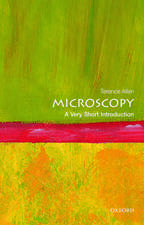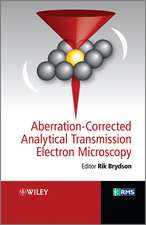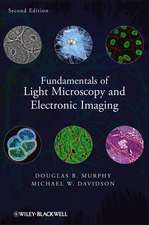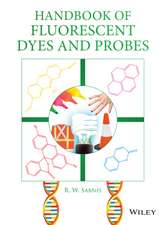Cytoskeleton Methods and Protocols: Methods in Molecular Biology, cartea 1365
Editat de Ray H. Gavinen Limba Engleză Hardback – 24 oct 2015
Authoritative and thorough, Cytoskeleton Methods and Protocols, Third Edition helps researchers expand their understanding of cytoskeleton structure and function.
| Toate formatele și edițiile | Preț | Express |
|---|---|---|
| Paperback (1) | 901.57 lei 43-57 zile | |
| Humana Press Inc. – 12 iul 2012 | 901.57 lei 43-57 zile | |
| Hardback (2) | 592.91 lei 38-44 zile | |
| Humana Press Inc. – 2 oct 2009 | 592.91 lei 38-44 zile | |
| Springer – 24 oct 2015 | 607.49 lei 38-44 zile |
Din seria Methods in Molecular Biology
- 9%
 Preț: 791.63 lei
Preț: 791.63 lei - 23%
 Preț: 598.58 lei
Preț: 598.58 lei - 20%
 Preț: 882.98 lei
Preț: 882.98 lei -
 Preț: 252.05 lei
Preț: 252.05 lei - 5%
 Preț: 802.70 lei
Preț: 802.70 lei - 5%
 Preț: 729.61 lei
Preț: 729.61 lei - 5%
 Preț: 731.43 lei
Preț: 731.43 lei - 5%
 Preț: 741.30 lei
Preț: 741.30 lei - 5%
 Preț: 747.16 lei
Preț: 747.16 lei - 15%
 Preț: 663.45 lei
Preț: 663.45 lei - 18%
 Preț: 1025.34 lei
Preț: 1025.34 lei - 5%
 Preț: 734.57 lei
Preț: 734.57 lei - 18%
 Preț: 914.20 lei
Preț: 914.20 lei - 15%
 Preț: 664.61 lei
Preț: 664.61 lei - 15%
 Preț: 654.12 lei
Preț: 654.12 lei - 18%
 Preț: 1414.74 lei
Preț: 1414.74 lei - 5%
 Preț: 742.60 lei
Preț: 742.60 lei - 20%
 Preț: 821.65 lei
Preț: 821.65 lei - 18%
 Preț: 972.30 lei
Preț: 972.30 lei - 15%
 Preț: 660.49 lei
Preț: 660.49 lei - 5%
 Preț: 738.41 lei
Preț: 738.41 lei - 18%
 Preț: 984.92 lei
Preț: 984.92 lei - 5%
 Preț: 733.29 lei
Preț: 733.29 lei -
 Preț: 392.60 lei
Preț: 392.60 lei - 5%
 Preț: 746.26 lei
Preț: 746.26 lei - 18%
 Preț: 962.66 lei
Preț: 962.66 lei - 23%
 Preț: 860.22 lei
Preț: 860.22 lei - 15%
 Preț: 652.64 lei
Preț: 652.64 lei - 5%
 Preț: 1055.50 lei
Preț: 1055.50 lei - 23%
 Preț: 883.87 lei
Preț: 883.87 lei - 19%
 Preț: 491.89 lei
Preț: 491.89 lei - 5%
 Preț: 1038.86 lei
Preț: 1038.86 lei - 5%
 Preț: 524.16 lei
Preț: 524.16 lei - 18%
 Preț: 2122.34 lei
Preț: 2122.34 lei - 5%
 Preț: 1299.23 lei
Preț: 1299.23 lei - 5%
 Preț: 1339.12 lei
Preț: 1339.12 lei - 18%
 Preț: 1390.26 lei
Preț: 1390.26 lei - 18%
 Preț: 1395.63 lei
Preț: 1395.63 lei - 18%
 Preț: 1129.65 lei
Preț: 1129.65 lei - 18%
 Preț: 1408.26 lei
Preț: 1408.26 lei - 18%
 Preț: 1124.92 lei
Preț: 1124.92 lei - 18%
 Preț: 966.27 lei
Preț: 966.27 lei - 5%
 Preț: 1299.99 lei
Preț: 1299.99 lei - 5%
 Preț: 1108.51 lei
Preț: 1108.51 lei - 5%
 Preț: 983.76 lei
Preț: 983.76 lei - 5%
 Preț: 728.16 lei
Preț: 728.16 lei - 18%
 Preț: 1118.62 lei
Preț: 1118.62 lei - 18%
 Preț: 955.25 lei
Preț: 955.25 lei - 5%
 Preț: 1035.62 lei
Preț: 1035.62 lei - 18%
 Preț: 1400.35 lei
Preț: 1400.35 lei
Preț: 607.49 lei
Preț vechi: 749.98 lei
-19% Nou
Puncte Express: 911
Preț estimativ în valută:
116.26€ • 120.93$ • 95.98£
116.26€ • 120.93$ • 95.98£
Carte tipărită la comandă
Livrare economică 09-15 aprilie
Preluare comenzi: 021 569.72.76
Specificații
ISBN-13: 9781493931231
ISBN-10: 1493931237
Pagini: 419
Ilustrații: XIII, 431 p. 91 illus., 38 illus. in color.
Dimensiuni: 178 x 254 x 30 mm
Greutate: 1.28 kg
Ediția:3rd ed. 2016
Editura: Springer
Colecția Humana
Seria Methods in Molecular Biology
Locul publicării:New York, NY, United States
ISBN-10: 1493931237
Pagini: 419
Ilustrații: XIII, 431 p. 91 illus., 38 illus. in color.
Dimensiuni: 178 x 254 x 30 mm
Greutate: 1.28 kg
Ediția:3rd ed. 2016
Editura: Springer
Colecția Humana
Seria Methods in Molecular Biology
Locul publicării:New York, NY, United States
Public țintă
Professional/practitionerCuprins
Long-Term Live Cell Imaging of Cell Migration: Effects of Pathogenic Fungi on Human Epithelial Cell Migration.- Live-Cell Imaging of Mitochondria and the Actin Cytoskeleton in Budding Yeast.- Imaging of the Actin Cytoskeleton and Mitochondria in Fixed Budding Yeast Cells.- Imaging of the Cytoskeleton Using Live and Fixed Drosophila Tissue Culture Cells.- Imaging Cytoskeleton Components by Electron Microscopy.- Purification and Localization of Intraflagellar Transport Particles and Polypeptides.- Fluorescence Imaging of the Cytoskeleton in Plant Roots.- Microtubules in Plant Cells: Strategies and Methods for Immunofluorescence, Transmission Electron Microscopy, and Live Cell Imaging.- Basic Methods to Visualize Actin Filaments In Vitro Using Fluorescence Microscopy for Observation of Filament Severing and Bundling.- An In Vitro Model System to Test Mechano-Microbiological Interactions Between Bacteria and Host Cells.- Reconstitution of a Minimal Actin Cortex by Coupling Actin Filaments to Reconstituted Membranes.- Use of Nanobodies to Localize Endogenous Cytoskeletal Proteins and to Determine Their Contribution to Cancer Cell Invasion by Using an ECM Degradation Assay.- Actin-Dynamics in Plant Cells: The Function of Actin Perturbing Substances: Jasplakinolide, Chondramides, Phalloidin, Cytochalasins, and Latrunculins.- Quantitative Motion Analysis in Two and Three Dimensions.- Measurement of Cell Motility Using Microgrooved Substrates.- The Study of Cell Motility by Cell Traction Force Microscopy (CTFM).- Melanosome Motility in Fish Retinal Pigment Epithelial (RPE) Cells.- Analysis of Stem Cell Motility In Vivo Based on Immunodetection of Planarian Neoblasts and Tracing of BrdU-Labeled Cells After Partial Irradiation.- Chemotaxis: Under Agarose Assay.- Functional Analysis of Actin-Binding Proteins in the Central Nervous System of Drosophila.- Proteomic Analysis of Cytoskeleton Proteins in Fish.- Using a Hand-Held Gene Gun forGenetic Transformation of Tetrahymena Thermophila.- Proteomic Tools for the Analysis of Cytoskeleton Proteins.- Homology Modeling Procedures for Cytoskeletal Proteins of Tetrahymena and Other Ciliated Protists.
Textul de pe ultima copertă
The third edition of this volume focuses on experimental models that are useful for investigating various aspects of cytoskeleton structure and function. Animal, plant, protist, and fungal models highlight twenty-four chapters that provide detailed protocols for live and fixed-cell imaging, dynamics of cytoskeleton components, cell and organelle motility, and genetics and proteomics. Written in the highly successful Methods in Molecular Biology series format, protocols in each chapter are up-to-date menus organized in a useful step-by-step format appropriate for novice and established investigators. Each chapter is equipped with a valuable notes section that provides a troubleshooting guide and helpful, and often unpublished, technical information aimed at ensuring success with implementation of the protocols.
Authoritative and thorough, Cytoskeleton Methods and Protocols, Third Edition helps researchers expand their understanding of cytoskeleton structure and function.
Authoritative and thorough, Cytoskeleton Methods and Protocols, Third Edition helps researchers expand their understanding of cytoskeleton structure and function.
Caracteristici
Includes cutting-edge methods and protocols Provides step-by-step detail essential for reproducible results Contains key notes and implementation advice from the experts
Recenzii
From the reviews of the second edition:
“In this second edition it is particularly stressed the cytoskeleton study at the different levels of life organization … . chapters incorporate a clear introduction, a useful lists of the necessary materials and reagents and the usual (so appreciated by beginners) step-by-step laboratory protocols to avoid the troubleshooting and pitfalls of the bench journey. Cell and developmental biologists are the primary targets as an audience … .” (Carlo Alberto Redi, European Journal of Histochemistry, Spring, 2010)
“The book contains an interesting mix of chapters some of which cover basic concepts and ideas that are easily transferrable to other systems and others that are more specialised. … overall the book contains many useful nuggets of information and will be very useful for anyone wanting to try out a new technique or approach covered by the various chapters.” (Michelle Peckham, Infocus Magazine, Issue 21, March, 2011)
“This second edition of Cytoskeleton Methods and Protocols … has the chapters written by different authors. Those authors which have highly experienced and are widely recognized as experts in their fields show in this book detailed protocols combining biochemistry, immunology, genetics, microscopy, and image analysis with integrative approaches for investigations of cytoskeleton components. Each protocol is provided with step-by-step instructions and informative notes that lead both novice and experienced investigators to a successful use. … serve as an ideal guide to different kind of investigators.” (Ricardo Ambrósio Fock, Brazilian Journal of Pharmaceutical Sciences, Vol. 47 (2), Summer, 2011)
“In this second edition it is particularly stressed the cytoskeleton study at the different levels of life organization … . chapters incorporate a clear introduction, a useful lists of the necessary materials and reagents and the usual (so appreciated by beginners) step-by-step laboratory protocols to avoid the troubleshooting and pitfalls of the bench journey. Cell and developmental biologists are the primary targets as an audience … .” (Carlo Alberto Redi, European Journal of Histochemistry, Spring, 2010)
“The book contains an interesting mix of chapters some of which cover basic concepts and ideas that are easily transferrable to other systems and others that are more specialised. … overall the book contains many useful nuggets of information and will be very useful for anyone wanting to try out a new technique or approach covered by the various chapters.” (Michelle Peckham, Infocus Magazine, Issue 21, March, 2011)
“This second edition of Cytoskeleton Methods and Protocols … has the chapters written by different authors. Those authors which have highly experienced and are widely recognized as experts in their fields show in this book detailed protocols combining biochemistry, immunology, genetics, microscopy, and image analysis with integrative approaches for investigations of cytoskeleton components. Each protocol is provided with step-by-step instructions and informative notes that lead both novice and experienced investigators to a successful use. … serve as an ideal guide to different kind of investigators.” (Ricardo Ambrósio Fock, Brazilian Journal of Pharmaceutical Sciences, Vol. 47 (2), Summer, 2011)












